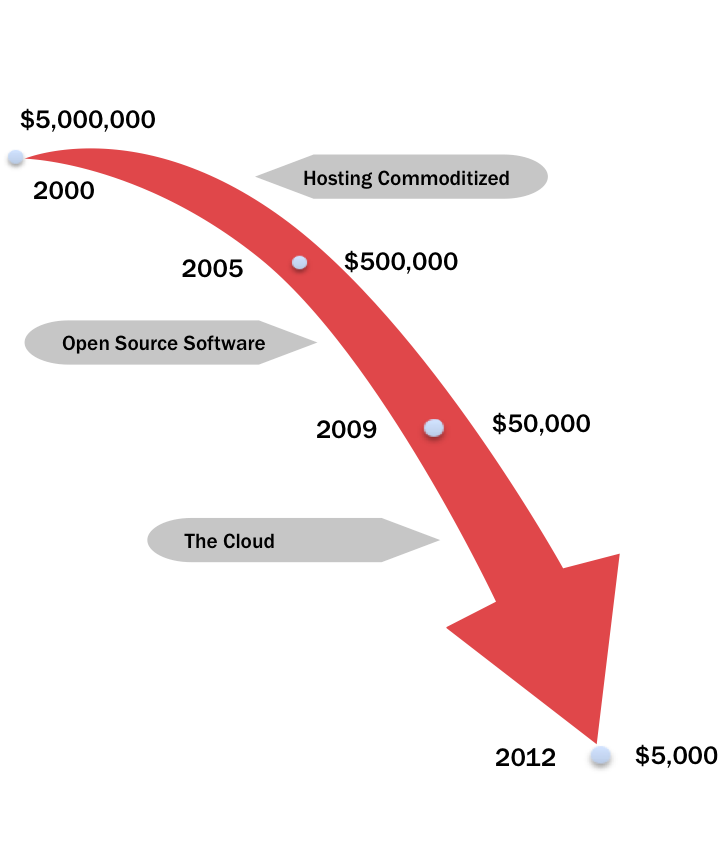Technology Alone Is Not a Strategy
“As information technology’s power and ubiquity have grown, its strategic importance has diminished. The way you approach IT investment and management will need to change dramatically … It is difficult to imagine a more perfect commodity than a byte of data – endlessly and perfectly reproducible at virtually no cost.” ~ Nicholas Carr
I was recently introduced to an apparently infamous article by Nicholas Carr, published in the Harvard Business Review, 2003. In this article, Carr asserts that Information Technology serves a similar purpose in industry as any other major technology has, such as railroads, the assembly line, or combustible engines. At first these innovations are proprietary and offer substantial advantage in the market, for those who posses this technology. But over time the technology becomes more common and standardized, providers more plentiful, competition rises, and consequently, the value of that technology becomes insignificant from a competitive perspective.
Others such as David Recardo and Karl Marx pontificated the Law of Diminishing Returns as far back as 1823, which says that the profits for a given unit will eventually be reduced to the marginal cost of production for an additional unit. So if it costs $1 to produce an additional cup of coffee, once the original template is perfected, then that is the eventual price target for that cup of coffee. Likewise, if the cost of production for a unit of software is $0, the eventual price target should be $0.
Having been introduced to this idea, I can already see commodization all around me in technology. For example, bandwidth and hosting costs are trivial now, compared to 10 years ago. So is the cost of a new laptop; well, unless you buy a Mac. Apple has managed to escape the commodity vacuum arguably by making their products not about the technology. When you look at the now famous marketing of the iPod for example, it wasn’t about Gigabytes or Megahertz. It was simply about “1000 songs in your pocket”. Likewise, Starbucks has overcome a long-since commoditized coffee industry by ex-halting coffee to a lifestyle experience. In both of these cases, the technology is the means, not the end goal.
If we look around me at where technology consulting firms are doing well now, its less about advising on building a better website. Outsourcing has certainly commoditized those skills, and open source software like WordPress the technology, and free design themes have commoditized the design concerns for most lower budget websites. Even writing better code is less important now with cheap RAM, CPUs, and mature concepts of server clustering.
The only place where money is really spent still for websites, is at the high-end advertising agencies. But it isn’t even about a website at that point; its about marketing strategy. And likewise, if you look around at which boutique web consulting companies are still doing well, it is those focusing on application of technology , not the production of it. SEO and Social marketing firms are red hot in 2011. And at the higher end of the market, even IBM has shifted away from technology and toward strategy consulting as their strategic executive Irving Wladawsky-Berger noted in 2003, that “we’ve entered the post-technology era”.
An article written by Timothy M. Chester in the Educase Quartely went as far as to say educators need to be mindful of training “future technology advocates and CIO leaders, not not leaders of technology mechanics”. Again, another recognition that the tide has shifted toward strategic use, not the implementation of. He further suggests that projects and budgeting should no longer be considered as IT projects, but rather as HR projects, Marketing projects, training products, etc – which happen to utilize IT for their implementation, similar to how a house or office building project would implement electricity and plumbing.

In another interesting data point, Mark Schuster, the famed LA Venture Capitalist, talks about why there has been an explosion of technology entrepreneurship in the past 10 years. He illustrates with a slideshow, how substantially the cost of (technology) has decreased for starting a business in 2011.The proliferation of cloud computing, APIs for “mashups”, open source frameworks, and low cost SaaS applications have dramatically reduced operating costs and increased opportunity to create compelling products by way of combining these technologies.
So if you are a technologist or a technical entrepreneur, what do you do with this information? Not everyone agreed with Carr’s assertions back in 2003, though I’d suspect he’d lave less detractors in 2012. And of course, there’s the likely possibility he is not entirely right, though I suspect there is at least a partial truth at work here.
What everyone in the industry seems hard at work on now however, is improvement of the application of these things. Whereas web development firms thrived a decade ago, it is now the SEO and social web agencies doing well. Improving social campaigns, improvement of conversion rates and landing pages for paid search marketing, and improvement of software as a solution product taking advantage of the cloud. Perhaps this is analogous to that period in the late 90’s when CPUs took quantum leaps every year until they eventually seemed good enough by the middle 200s, and that extra speed no longer was critical to the end-businesses.
So where do we go from here? Companies like Apple and Starbucks have the right idea – they’re not focused on the commodity as the end goal. Rather, they use it as a key implementation factor, while the marketing message is about something entirely different. They are both selling the value of a superior offering, rather than focusing on the features of a commodity, a key lesson in sales by the way.